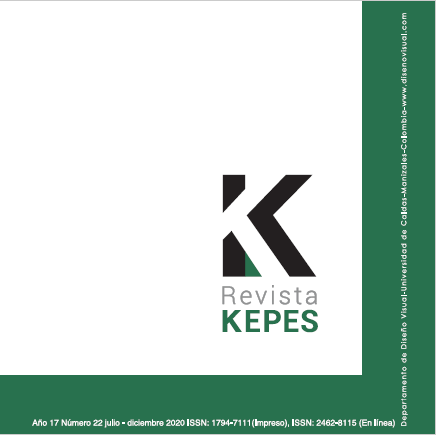Authors
Abstract
This research explores academic practices about visualization, with the objective of defining the importance of the realization of diagrams for academic research in design. The case study focused on students in the last semesters of the Bachelor of Arts jn Graphic Design at Universidad del Valle who were carrying out their undergraduate research project to qualify for the university degree. Methods: in this qualitative research, participatory observation of the subject areas dealing with research projects was carried out, in addition to semi-structured interviews with department professors and students about to finish their undergraduate studies. In the final part of the interview students were asked to explain their projects while drawing on a paper. An analysis of the relationship between the graphics and the oral defense of projects was carried out. Scrutiny within the conversation, to identify the categories of visualization, academic writing and design research, was carried out in the analysis of the transcribed interviews. Results: The information collected shows that visualization is a fundamental communicative practice in the development of undergraduate research projects, not only to discuss with pairs and advisors, but also as a way to raise awareness of cognitive processes that are part of the research process. Conclusion: The effective incorporation of visual methods in training research classes could help students use more effectively cognitive resources acquired in their training years at the university and even to reduce the perceived gap between the professional practice of design and the theoretical reflection about the practice. Future studies could focus on the application of these didactic resources in research activities to check if it is possible to define a methodological toolbox related to the particular interests of design.
References
Bonsiepe G. (2007). The Uneasy Relationship between Design and Design Research. En R. Michel (Ed.), Design Research Now. Board of International Research in Design (pp 25-39). Birkhäuser Basel. https://doi.org/10.1007/978-3-7643-8472-2_2
Carlino, P. (2004). Escribir a través del currículum. Tres modelos para hacerlo en la universidad. Lectura y vida, 25(1), 16-27. https://media.utp.edu.co/referencias-bibliograficas/uploads/referencias/articulo/248-escribir-a-travsdel-curriculum-tres-modelos-para-hacerlo-en-la-universidadpdf-jQyDBarticulo.pdf
Chaves, N. (2001). El oficio de diseñar. Propuestas a la consciencia crítica de los que comienzan. Gustavo Gili.
Cross, N. (2007) From a Design Science to a Design Discipline: Understanding Designerly Ways of Knowing and Thinking. En R. Michel (Ed.), Design Research Now. Board of International Research in Design (pp. 41-54). Birkhäuser Basel. https://doi.org/10.1007/978-3-7643-8472-2_3
Diezmann, C. (2009). The visual side to numeracy: students’ sensemaking with graphics. Australian Primary Mathematics Classroom, 14(1), 16-20. https://www.researchgate.net/publication/27476219_The_visual_side_to_numeracy_Students’_sensemaking_with_graphics
Findeli, A., Brouillet, D., Martin, S., Moineau, C. y Tarrago, R. (2008). Research Through Design and Transdisciplinarity: A Tentative Contribution to the Methodology of Design Research. En Swiss Design Network (Ed.), Focused - Current Design Research Projects and Methods (pp. 67-88). Swiss Design Network Simpossium. https://www.academia.edu/14939794/Research_through_design_and_transdisciplinarity_A_tentative_contribution_to_the_methodology_of_design_research
Frayling, C. (1993). Research into Art & Design. Royal College of Art. https://researchonline.rca.ac.uk/384/3/frayling_research_in_art_and_design_1993.pdf
Friendly, M. (2008). Handbook of Computational Statistics: Data Visualization. Springer Berlin Heidelberg.
Gardner, H. (1993). Estructuras de la mente. La teoría de las inteligencias multiples. Basic Books.
Hansen, Y. (2000). Visualization for thinking, planning, and problem solving. En R. Jacobson (Ed.), Information Design (pp. 193-220). The MIT Press.
Harley, J. (1987). The Map and the Development of the History of Cartography (Vol. I). The University of Chicago Press.
Heilman, K. (2005). Knowledge and talents. En K. Heilman, Creativity and the brain (pp. 27-58). Psychology Press.
Maya, J, y Mazo, E. P. (2020). Propiedades de las representaciones en diseño: una exploración interdisciplinaria de su rol funcional. Kepes, 17(21), 17-60. doi: 10.17151/kepes.2020.17.21.2
Moles, A. y Costa, J. (1991). Imagen didáctica. Ediciones Ceac.
Pontis, S. (2009). Diseño gráfico: un novel objeto de investigación. Caso de estudio: el proceso de diseño. Iconofacto, 5(6), 9-18. https://dialnet.unirioja.es/servlet/articulo?odigo=5204254
Rajamanickam, V. (2005). Infographics Seminar Handout. Industrial Design Center Indian Institute of Technology. http://www.schrockguide.net/uploads/3/9/2/2/392267/infographic_handout.pdf
Restrepo, J. (2008). La investigación en los programas de diseño gráfico en Colombia. Iconofacto, 4(5), 114-121. https://dialnet.unirioja.es/servlet/articulo?codigo=5204290
Rincón, G. y Gil, J. S. (2013). Lectura y escritura académica en la Universidad del Valle. Caracterización de prácticas y tendencias. Programa Editorial Universidad del Valle.
Scrivener, S. (2009). The Roles of Art and Design Process and Object in Research. In N. Nimkulrat & T. O’Riley (Eds.), Reflections and Connections. On the relationship between creative production and academic research. University of Art and Design Helsinki.
Self, J., Lee, S., y Bang, H. (2015). Perceptions of complexity in design representation: Implications for an understanding of design practice. The International Journal of Design Management and Professional Practice, 9(4), 33-46. https://www.researchgate.net/publication/298708197_Perceptions_of_Complexity_in_Design_Representation_Implications_for_an_Understanding_of_Design_Practice
Tufte, E. (1992). Envisioning Information. Graphics Press.
Tversky, B. (2005). Visuospatial Reasoning. En K. Holyoak, y R. Morrison (Eds.). The Cambridge Handbook of Thinking and Reasoning (pp. 209-241). Cambridge University Press.
Universidad del Valle. (2017). Reglamento de proyecto de grado. Diseño Industrial/Diseño Gráfico. Comité de programas académicos, Departamento de Diseño.

 pdf (Español (España))
pdf (Español (España))
 FLIP
FLIP






















